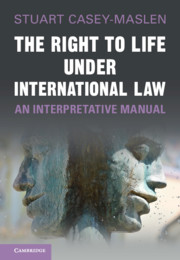Book contents
- The Right to Life under International Law
- The Right to Life under International Law
- Copyright page
- Contents
- Foreword
- Acknowledgements
- Table of Cases
- An Historical Introduction to the Right to Life
- Part I Overview of the Right to Life under International Law
- Part II Major Themes
- Part III The Protection of At-Risk Groups and Individuals
- 21 Women
- 22 Children
- 23 Racially Motivated Killings
- 24 LGBTI Persons
- 25 Persons with Disabilities
- 26 Older Persons
- 27 Journalists
- 28 Human Rights Defenders
- 29 International Migrants
- 30 Internally Displaced Persons
- 31 Refugees
- Part IV Accountability
- Part V Human Rights Machinery Protecting the Right to Life
- Part VI Outlook
- Index
23 - Racially Motivated Killings
from Part III - The Protection of At-Risk Groups and Individuals
Published online by Cambridge University Press: 02 September 2021
- The Right to Life under International Law
- The Right to Life under International Law
- Copyright page
- Contents
- Foreword
- Acknowledgements
- Table of Cases
- An Historical Introduction to the Right to Life
- Part I Overview of the Right to Life under International Law
- Part II Major Themes
- Part III The Protection of At-Risk Groups and Individuals
- 21 Women
- 22 Children
- 23 Racially Motivated Killings
- 24 LGBTI Persons
- 25 Persons with Disabilities
- 26 Older Persons
- 27 Journalists
- 28 Human Rights Defenders
- 29 International Migrants
- 30 Internally Displaced Persons
- 31 Refugees
- Part IV Accountability
- Part V Human Rights Machinery Protecting the Right to Life
- Part VI Outlook
- Index
Summary
This chapter describes the duty of States to respect and protect the right to life by preventing and prosecuting racially motivated killings. Race is central to the protection of fundamental human rights, including the right to life. Indeed, the development of the Charter of the United Nations was a response to the Holocaust perpetrated against the Jews and the extermination of Roma in the Second World War. Massacres and atrocities have, however, since been perpetrated on every continent: against Tutsis in Rwanda; against Bosniak Muslims in Bosnia and Herzegovina; and against Uighurs in China, among many others. In 1988, the Iraqi air force aircraft supported by artillery dropped the nerve agent Sarin and mustard gas on the Kurdish town of Halabja in the north of the country. Thousands of people – mainly women and children – died that day, with up to 12,000 believed to have lost their lives since as a result of the effects of the chemical weapons.
Keywords
- Type
- Chapter
- Information
- The Right to Life under International LawAn Interpretative Manual, pp. 493 - 514Publisher: Cambridge University PressPrint publication year: 2021

